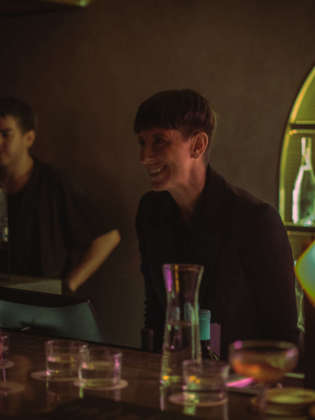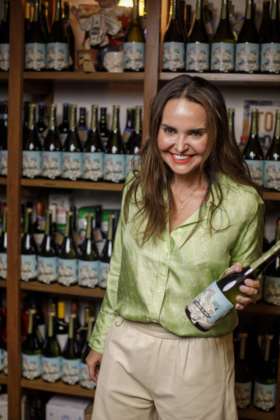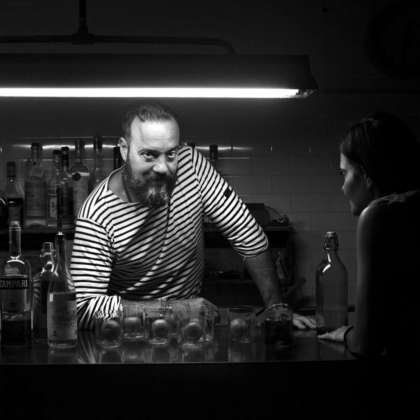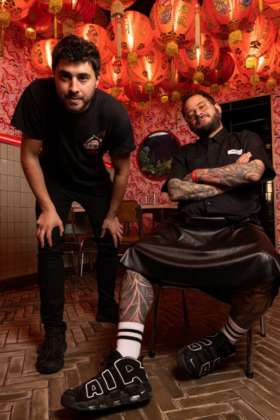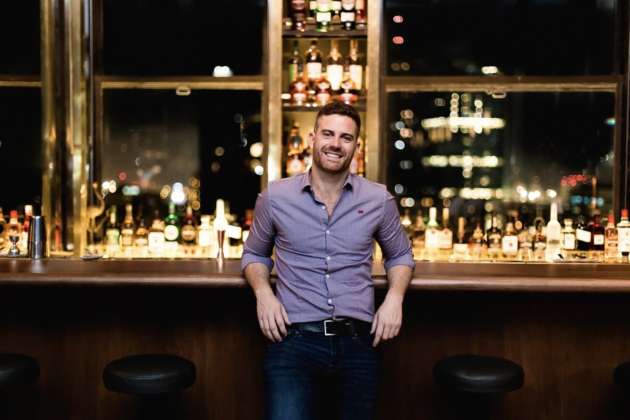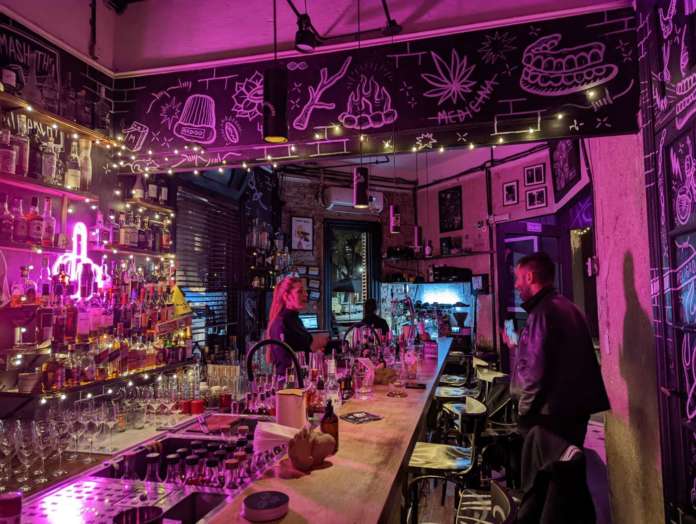
Buenos Aires, situata sulla sponda occidentale del Río de la Plata, sulla costa sud-orientale, è la città più visitata del Sud America. È nota per la sua architettura europea eclettica e per la sua eterogenea composizione etnica, dovuta al grande afflusso di immigrati tra la fine del XIX e la prima metà del XX secolo, provenienti in particolare dall’Italia e dalla Spagna. Stimolata dall’arrivo degli europei, la scena dei cocktail bar a Buenos Aires ha una ricca storia che risale a un secolo fa.
L’argentino Sebastián “Seba” Atienza, proprietario dei bar Tres Monos e La Uat di Buenos Aires, descrive così l’evoluzione della cultura del bere nella sua città: «Credo che Buenos Aires sia diventata la capitale dell’industria dei cocktail latino-americani grazie alla forte immigrazione italiana e spagnola del passato. Negli anni Cinquanta abbiamo avuto alcuni dei più importanti personaggi di riferimento del bartending mondiale, tra cui Santiago Pichin Policastro, che ha scritto il libro “Magic Drinks”. Alla fine degli anni ‘90, Buenos Aires ha iniziato la sua seconda età dell’oro nel settore dei drink grazie a locali come il Gran Bar Danzón, dove hanno esordito gli eroi del bartending locale Tato Giovannoni e Inés De Los Santos. Poi è stata la volta del Mundo Bizzaro di Pablo Piñata, che ha ispirato l’apertura di Tres Monos». Di seguito vi proponiamo un viaggio tra i migliori cocktail bar di Buenos Aires, partendo da un noto bar in cui in passato Sebastián era l’head bartender, e concludendo la serata al Tres Monos e a La Uat, di proprietà di Seba. Si unisce a noi Sorrel Moseley-Williams, giornalista e sommelier inglese, in Argentina dal 2006, presidente dei World’s 50 Best Bars per il Sud America e profonda conoscitrice della realtà locale.
Floreria Atlantico
Iniziamo dal quartiere Retiro di Buenos Aires, noto per i suoi negozi di alto livello, i sontuosi edifici residenziali, i vicini terminal ferroviari e l’antica zona delle banchine marittime, che un secolo fa rappresentava il punto di ingresso principale per milioni di immigrati. Sempre a Retiro si trova Florería Atlántico, un bar che si ispira al forte carattere multiculturale di Buenos Aires. Florería Atlántico è stato fondato dieci anni fa da Renato “Tato” Giovannoni, uno dei più noti barman del Sud America. Premiato come Miglior Bartender a The World’s 50 Best Bars nel 2020, Tato è cresciuto a Pinamar, una cittadina costiera a sud di Buenos Aires, e ha iniziato la sua carriera nel settore dell’ospitalità nel bar del padre. L’interesse per il cinema lo ha portato a studiare alla New York Film Academy, ma i bei ricordi di quando era barista in riva al mare argentino erano sempre presenti nella mente di Tato. Così, all’inizio degli anni 2000 è tornato nella sua terra natale e ha iniziato a lavorare al Gran Bar Danzón, di ispirazione newyorkese, facendo il barman al fianco di Inés De Los Santos, la talentuosa mixologist responsabile di altri due bar che visiteremo in questo tour. Dopo le esperienze come barman al Sucre e all’Hotel Faena, Tato voleva creare qualcosa di veramente suo. Nel 2013, Tato e la socia Aline Vargas hanno aperto Florería Atlántico.
Al bar si accede passsando per un negozio che vende fiori e vini. Mentre nelle prime ore della sera, l’ingresso segreto del cocktail bar al piano inferiore diventa accessibile attraverso la porta di un frigorifero. Scendendo le scale, vediamo le pareti adornate da incantevoli creature marine mitologiche, disegnate a mano dall’artista Tato, e il personale che indossa magliette a righe in stile marinaro. La sensazione è di essere finiti in una taverna di mare d’altri tempi. Il servizio è effettuato su uno dei banconi più grandi al mondo. Si parla di 18 metri di lunghezza per 27 posti. Florería Atlántico attira persone del posto, ma è anche apprezzata dal pubblico internazionale, sia dai consumatori sia dalla industry, e attualmente è al 18° posto nella classifica di The World’s 50 Best Bars. Per i primi sei anni, il menu dei cocktail della Florería Atlántico era esclusivamente dedicato ai Paesi con il maggior afflusso di immigrati in Argentina all’inizio del XX secolo: Italia, Spagna, Francia, Polonia e Inghilterra. Nell’ultimo menu “Pueblos Originarios”, giunto al secondo volume, l’attenzione è invece rivolta alle colonie e alle città native dell’Argentina. Secondo Tato: «Alcune colonie hanno avuto grande successo e sono diventate città fiorenti, mentre altre, come la colonia belga di Ostenda, sono fallite. Tuttavia, ognuna di queste colonie, alcune create anche da un mix di nazionalità, ha una storia da raccontare, cosa che speriamo di fare attraverso i nostri nuovi signature cocktail alla Floreria». La co-fondatrice Aline Vargas è molto soddisfatta dell’ultimo menu, frutto di un lavoro di squadra: «Anche se curato da Tato, sono stati i “Marineros” a dedicare sette mesi alla ricerca, allo studio e all’approfondimento di tutte le popolazioni native del Paese e dei loro prodotti. Io e Tato siamo molto orgogliosi del lavoro che hanno svolto, perché sono maggiormente responsabilizzati e ciò li mette in condizione di crescere come bartender».
Trade
Non lontano da Florería Atlántico si trova Trade, dove si può ammirare il tramonto dal rooftop più spettacolare di Buenos Aires. Con i suoi drink, principalmente da aperitivo, e la sua vista unica, non sorprende che Time Out lo abbia classificato tra i migliori rooftop bar del mondo. Il cofondatore Andrés Rolando, che ha già riscosso successo nella scena gastronomica locale con Uptown e Nicky Harrison, voleva creare qualcosa che secondo lui mancava a Buenos Aires: un grande rooftop bar. Secondo Andrés «Trade è un bar che attira molti turisti, ma credo anche che sia un luogo dove il porteño, il cittadino di Buenos Aires, possa riscoprire la sua città». Sebbene la maggior parte dei clienti sia attirata dal rooftop al 22° piano, ideale per Instagram, e dai suoi drink più leggeri come Spritz e Gin Tonic, al Trade trova spazio anche un bar più intimo, tre piani più sotto, che serve “drink da meditazione”.
Niño Gordo
Ci spostiamo a 20 minuti di taxi verso la zona di Palermo, l’epicentro della vita notturna di Buenos Aires per visitare il Niño Gordo, un locale che sposa buon cibo a buoni drink. In una città che offre ristoranti di fama mondiale come El Preferido, Don Julio e Mishiguene, è una vera sfida distinguersi nella folla gastronomica, ma i due soci Germán Sitz e Pedro Peña ci sono riusciti. I due hanno seguito percorsi simili per dieci anni, lavorando in cucina in Argentina e nel mondo, per poi unire le forze e aprire alcuni ristoranti a Buenos Aires. Il locale di maggior successo è Niño Gordo, un hotspot culinario alla moda che abbina le specialità alla griglia asiatiche ai sapori di Buenos Aires. Prima di aprire Niño Gordo, Pedro ha fatto pratica per 4 mesi nelle migliori cucine della Corea e del Giappone, in modo da potere applicarne le tecniche alla carne argentina. L’obiettivo dei due imprenditori è far sperimentare agli ospiti un viaggio in Asia fin dal momento in cui mettono piede nel ristorante, con un set molto scenografico caratterizzato da luci al neon rosse e da elementi di design tratti dalla cultura pop asiatica. In effetti, Germán ammette che il progetto è stato interamente guidato dal marketing: «Quando abbiamo aperto il ristorante volevo che tutti coloro che entravano si scattassero un selfie e lo condividessero su Instagram, perché sapevamo che sarebbe servito a far crescere l’attività». Ma oltre all’aspetto fotogenico, è l’inedita proposta fusion asiatico-argentina, finora sconosciuta a Buenos Aires, a far tornare la gente al Niño Gordo.
Il piatto signature è il Katsu Sando, con la steak argentina di alta qualità proveniente dalla fattoria della famiglia di Germán a La Pampa, tonkatsu e maionese giapponese tra due fette di pan brioche. Abbinandolo al Takechi Kitano, un drink stile Collins con gin, succo di litchi, succo di limone, soda e una spruzzata di Malbec argentino, è quel genere di pairing capace di convincere anche i più scettici all’idea di fondere i sapori argentini con quelli asiatici.
Cochinchina
Dopo il Niño Gordo ci dirigiamo al CoChinChina, un altro locale Asian-fusion nel quartiere Palermo. Lanciato dalla leggenda del settore Inés De Los Santos, CoChinChina prende il nome dalla parte più meridionale del Vietnam, un tempo colonia francese. Inés ha avuto l’idea di CoChinChina durante la pandemia: «Ho visitato per la prima volta lo spazio durante la quarantena, e ho iniziato a pensare a quale tipo di bar creare. Ma considerata la situazione del lockdown, ho iniziato a sognare di viaggiare e il mio primo pensiero è stato quello di visitare la Francia, probabilmente perché mio marito è francese e lo era anche mio padre. Ma a un certo punto, visto che di sogni si trattava, ho pensato di andare ancora più in là: in Asia»! E così che Inés è riuscita a riunire il meglio di due mondi: i sapori del sud del Vietnam e il suo amore per la Francia.
Al piano superiore del locale si trova l’elegante Arriba, uno spazio più intimo e rilassato, incentrato su cocktail sofisticati che richiedono più tempo per la preparazione. Uno dei drink di punta del menu è il El Derty, un Dirty Martini con gin Tanqueray, salamoia di capperi e vermouth Torrontés extra dry dell’amico di lunga data Tato Giovannoni. In soli due anni dall’apertura, CoChinChina ha ricevuto diversi riconoscimenti internazionali, tra cui il 42° posto nella classifica di The World’s 50 Best Bars 2022. Inés ha condiviso le sue riflessioni sul successo del bar: «Sono molto contenta dei nostri risultati, di vedere il team felice, di festeggiare e di capire che il loro sforzo quotidiano viene riconosciuto». Inés, che si è anche classificata al 33° posto nell’edizione 2023 della Bar World 100 list di Drinks International, è orgogliosa di essere una delle esponenti di spicco delle donne barman in Sud America. Ogni giorno ci sono più donne nel settore, ma la strada da percorrere è ancora lunga. Sono molto felice di rappresentare le donne, perché lavoro duramente da molti anni». Inés non è una che si adagia sugli allori, infatti ha aperto il concept giapponese Kona, con un ristorante al piano terra che propone la cucina della chef stellata Narda Lepes e un bar al primo piano con le creazioni liquide di De La Santos. Oltre a Narda e Inés, il progetto di Kona è firmato da architetti e designer donne.
«Aprendo Kona con la sua amica Narda, una potenza gastronomica, Inés continua a dimostrare la sua incredibile capacità di entusiasmare i consumatori e di ispirare la prossima generazione di donne che si affacciano sul mondo del lavoro», aggiunge la giornalista Sorrel.
El Limón
A 10 minuti a piedi da CoChinChina si trova El Limón, bar di quartiere per eccellenza creato da Lucas López Dávalos, da vent’anni nel circuito dei bar di Buenos Aires. Proprio come l’ABV di San Francisco, El Limón attira come una calamita grazie alla sua grande finestra aperta a destra dell’ingresso che permette sia di sbirciare all’interno per osservare l’azione al banco del bar, sia ai bartender di interagire con gli ospiti all’esterno. L’atmosfera rilassata e tranquilla del locale, unita a una lista di drink concisa ma deliziosa, potrebbe spingere l’ospite a cercare un appartamento a Palermo, solo per poter chiamare El Limón il suo bar di quartiere. A rendere ancora più accogliente l’atmosfera di El Limón è il banco del bar, che si trova alla stessa altezza delle postazioni di lavoro, creando così maggiore sintonia e contatto visivo con il team del bar.
Tres Monos
Nessun viaggio nel quartiere di Palermo può dirsi completo senza una visita al Tres Monos, inaugurato nel 2019 da Sebastián Atienza e Charly Aguinsky a cui si è recentemente aggiunto un terzo collaboratore, Gustavo Vocke. Il nome Tres Monos si ispira alle tre scimmiette sagge della cultura giapponese, ma anche ai tre protagonisti dell’attività, che oltre al bar si occupano di formazione e consulenza. Tres Monos Estudio organizza masterclass e workshop in presenza e online con esperti di bartending, tra cui i soci di Tres Monos, Sebastián, Charly e Gustavo, ma anche altri esperti locali come Inés De Los Santos.
Per sostenere la comunità meno fortunate, Tres Monos organizza lezioni nel Barrio Mugica, una delle aree disagiate di Buenos Aires. Abbiamo chiesto a Charly Aguinsky di parlarci del progetto Barrio Mugica: «Per noi l’istruzione è sempre stata di vitale importanza. Il lavoro che stiamo svolgendo nel Barrio Mugica mi rende davvero orgoglioso. Sono parte di un’organizzazione che ha a cuore il futuro dei giovani e si adopera per fornire loro le competenze necessarie per farsi una carriera». Entrando nel bar Tres Monos con le luci rosa al neon, opere di writing e muri ricoperti di graffiti con frasi ad effetto come “#FuckYourLikes”, ci si rende subito conto di non essere nel solito cocktail bar. All’ottimo lavoro sugli interni si aggiunge una proposta di drink altrettanto seria fatta di specialità come il Fuck Your Mojito a base di gin argentino Principe De Los Apóstoles, menta, citronella e cumino. Il successo di Tres Monos ha spinto recentemente i titolari a raddoppiare le dimensioni, rilevando il locale adiacente e aggiungendo altri posti a sedere all’esterno per servire fino a 140 persone. Ma le novità non finiscono qui perché Charly e Sebastián hanno appena aperto un altro locale. Si tratta di La Uat, aperto fino alle 4 del mattino. «La Uat - dice Sebastian - è una discoteca incentrata sugli anni ‘80, un decennio divertente e colorato. La si può considerare come il fratello più cool di Tres Monos».
Nonostante la crisi economica argentina, Buenos Aires ha visto aumentare il numero di locali food & beverage. Abbiamo chiesto a Charly Aguinsky di delinearci quale sarà il futuro della cultura dei cocktail in città. «Penso che negli ultimi anni ci sia stata una tendenza positiva nella comunità dei bar, con l’apertura di bar come Tres Monos, un esempio di locale non solo gestito, ma anche di proprietà dei bartender. La combinazione di questi locali con quelli già esistenti ha fatto diventare Buenos Aires una città molto stimolante in termini di alternative disponibili per bere un drink. A dare ulteriore impulso alla crescita dei nostri bar sono i bartender locali, che sono alla costante ricerca di nuovi sapori, ma anche i consumatori, sempre più desiderosi di provare qualcosa di nuovo. Sono assolutamente convinto che la scena dei cocktail a Buenos Aires continuerà a espandersi e diventerà una delle città più importanti al mondo per i drink». Come Aguinsky, anche Tato Giovannoni nutre grandi speranze per il futuro dei cocktail in Argentina: «Il successo della cultura argentina dei cocktail, dai bar agli alcolici, è il risultato di un duro lavoro di molti anni in un’unica direzione: mostrare quello che l’Argentina ha da offrire, sia al mondo sia agli argentini. Tuttavia, questo è un momento di transizione, in cui sta nascendo una nuova generazione di giovani motivati che lanciano nuovi bar e prodotti».
«Molti giovani talenti hanno colto l’opportunità di mettersi in proprio o di ampliare il proprio portafoglio - aggiunge Sorrel Moseley-Williams -. El Limón, Chintoneria e La Uat sono un ottimo esempio, mentre negli ultimi due anni sono stati aperti numerosi wine bar, come Vini, Diviiino e Lardito. Penso che dobbiamo ringraziare la pandemia per aver dato alle persone la possibilità di iniziare a costruire il loro percorso personale». «La mia speranza - conclude Giovannoni - è che i nuovi arrivati traggano profitto dal lavoro della vecchia generazione e sviluppino nuovi trend, ma senza dimenticare le belle tradizioni argentine».
English version
Buenos Aires bar tour
Buenos Aires, located on the western shore of the Río de la Plata on South America's southeastern coast, is the most visited city in South America. It is known for its eclectic European architecture and diverse ethnic make-up thanks to the large influx of immigrants in the late 19th and first half of the 20th century, particularly from Italy and Spain. Spurred on by the arrival of Europeans, the cocktail bar scene in Buenos Aires has a rich history that stretches back a century. Argentine Sebastián “Seba” Atienza, owner of Tres Monos and La Uat bars in Buenos Aires gave us his insight on the evolution of drinking culture in his city: “I believe Buenos Aires is the capital of the Latin American cocktail industry due to the strong Italian and Spanish immigration of the past. In the 1950s we had some of the most important reference points for bartending in the world including Santiago Pichin Policastro, who penned the book “Magic Drinks”. In the late 1990s, Buenos Aires began its second golden age of drinking thanks to bars such as Gran Bar Danzón, where local bartending heroes Tato Giovannoni and Inés De Los Santos got their start. Next, there was Pablo Piñata’s Mundo Bizzaro, which was the inspiration behind the opening of Tres Monos”.
Below we take you a journey of the best cocktail bars of Buenos Aires, starting with a well-known bar where Sebastián was formerly the head bartender, and ending the night at Seba’s very own Tres Monos and La Uat. Joining us for the tour is Sorrel Moseley-Williams, a British freelance journalist and sommelier living in Argentina since 2006 and academy chair of World’s 50 Best Bars (South America).
Floreria Atlantico
We start in Buenos Aires’ Retiro neighborhood, known for its high-end shops, lavish residential buildings, nearby rail and bus terminals, and the old docks area, which was the primary point of entry for millions of immigrants a century ago. Retiro is also home to Floreria Atlantico, a bar that was inspired by Buenos Aires’ strong multicultural character. Floreria Atlántico was founded in 2013 by Renato “Tato” Giovannoni, one the best-known bartenders in South America.
Awarded the Bartender’s bartender at the World’s 50 Best Bars in 2020, Tato grew up in Pinamar, a coastal town south of Buenos Aires and started his hospitality career at his father’s bar. An interest in film led him to study at the New York Film Academy, but the fond memories of bartending on the Argentinian seaside were always on Tato’s mind. And so, he returned to his native land in the early 2000s and began working at the New York-inspired Gran Bar Danzón, bartending alongside Inés De Los Santos, the talented female mixologist responsible for two more bars that we’ll visit on our bar tour. After bartending experiences at Sucre and the Faena Hotel, Tato wanted to create something he could call his own. In 2013, Tato and partner Aline Vargas opened Florería Atlántico together in the Retiro district. An ode to Argentina’s diverse population, Florería Atlántico has an atmosphere and drink list that celebrate the best imported products from centuries of immigration, which have come to define the country’s unique drinking culture.
The entrance to Florería is from a street level flower and wine shop. In the early evening, the secret entrance to the downstairs cocktail bar becomes accessible through a refrigerator door. Down the stairs, enchanting mythological sea creatures, hand drawn by the artistic Tato, adorn the walls, with the staff dressed in handsome navy-striped shirts. You’ll feel like you’re at a seaside tavern from another era, drinking alongside other eclectic immigrants at the 27-stool, 18-m long bar counter, one of the longest in the world. Florería Atlántico attracts a wide range of Buenos Aires locals but is also esteemed by the international crowd, both consumers and industry, currently ranked 18th on the World’s 50 Best Bars.
For the first six years, Florería Atlántico‘s cocktail menu was exclusively devoted to the countries with the largest influx of immigrants to Argentina in the early 20th century: Italy, Spain, France, Poland, and England. In the latest menu “Pueblos Originarios”, now on Vol. II, the focus is instead on colonies and native towns in Argentina.
According to Tato: “Some colonies had great success and became thriving towns, while others, for example the Belgian colony of Ostende, failed. However, each of these colonies, some created even by a mix of nationalities, has a story to tell, which we hope to do through our new signature cocktails at Floreria”.
Co-founder Aline Vargas is very happy with the latest menu, which was a full team effort: “Although curated by Tato, it was the “Marineros” who spent seven months researching, studying and learning in depth about all the native peoples of the country and their products. Tato and I take enormous pride in this, because it gives them more responsibility, allowing them to grow as bartenders”.
The Retiro-based bar has certainly set the standard over the past decade, according to Sorrel Moseley-Williams: “Tato and team have long captivated drinkers by tapping into Argentina’s cultural melting pot. But the latest drinks list, focusing on very specific communities, sheds new light on Argentina’s history.”
Trade
A 20-minute stroll from Florería Atlántico is Trade, where we catch the sunset from the most spectacular rooftop in Buenos Aires. Trade is located on the 22nd floor of the Buenos Aires Art Deco Comega building constructed in 1934. Trade first opened its doors in 2019, and offers stunning views of the iconic Obelisk, the renovated docks area Puerto Madero, the River Plate, and on clear days, neighbouring country Uruguay. With fun aperitivo style drinks and its second to none vistas, it is no surprise that Time Out ranked Trade among the best rooftop bars in the world.
Co-founder Andrés Rolando, who has already achieved success in the local food and beverage scene with Uptown and Nicky Harrison, wanted to build something that he thought was missing in Buenos Aires, a great rooftop bar. “We felt that there were no bars where you could admire the city from above”. Andrés and his business partners came across an opportunity at the historic Comega Building and its strategic rooftop. “Chicago, New York, Paris, London, Tokyo all have rooftops that are mandatory stops for tourists and locals alike. And we felt that Buenos Aires needed one too”.
The charm of Trade Sky Bar is its dual nature, with Art Deco touches that make you feel like you’re in New York, but a view that reminds you that you’re in the capital of Argentina. According to Andrés "Trade is a bar that attracts a lot of tourists, but I also believe that it is a place where the porteño can rediscover his own city".
Although most are drawn to the Instagram-friendly 22nd floor roof top and its lighter cocktails such as spritzes and gin and tonics, you can also find a more intimate bar three floors down, serving more elaborate meditation style after-dinner drinks.
Niño Gordo
We next move 20 minutes by taxi to Buenos Aires’ Palermo area, the nightlife epicenter of Buenos Aires. With our pre-dinner drinking done, it’s time to add a bit of food to the mix. In a city that offers world class dining venues such as El Preferido (No.22 Latin America's 50 Best Restaurants 2022), Don Julio (No.19 The World's 50 Best Restaurants 2023) and Mishiguene (No.15 Latin America's 50 Best Restaurants 2022), it’s a challenge to stand out in the gastronomic crowd in Buenos Aires. But business partners Germán Sitz and Pedro Peña have done just that with Niño Gordo.
Pedro and Germán had been on similar paths for 10 years, working in kitchens in Argentina and the world, and one day decided to join forces to open restaurants in Buenos Aires. German explained how the partnership started: “When we met and we told each other about our dreams, we realized that we had a lot in common and so we decided to open restaurant venues together”. The duo’s most successful restaurant to date is Niño Gordo, a hip culinary hotspot that combines Asian grill with the flavours of Buenos Aires.
Before opening Niño Gordo, Pedro trained for 4 months in Asian techniques in top kitchens in Korea and Japan so that he could apply these methods to Argentinian meat. “Before Niño Gordo, Asian restaurants in the city were all highly specialized. We wanted to unify the flavors and techniques I learned from my travels, and combine them with signature, local Argentinian products”.
Pedro and German’s goal for Niño Gordo is for guests to experience a journey through Asia the moment they set foot in the restaurant, which features red neon lights and playful design elements from Asian pop culture. In fact, German admits the design was entirely marketing driven: “When we first started the restaurant, I wanted everyone who came in to take a selfie and share it on Instagram, which we knew would help the business grow”.
But other than being photogenic, it is the delicious Asian-Argentinian fusion, previously unknown to Buenos Aires, that keeps people coming back to Niño Gordo. The signature dish is the Katsu Sando, with high quality Argentinian steak from German’s family farm in La Pampa, tonkatsu and Japanese mayonnaise between two slices of pan brioche bread. Pair that with Takechi Kitano, a Collins style drink with gin, lychee juice, lemon juice, soda and a float of Argentinian Malbec, and you too will be convinced by German and Pedro’s well-executed concept of fusing Argentinian and Asian flavors.
“While most diners come for the fantastic signature dishes such as the Sando, the steak Tataki or sweet chilli and miso sweetbreads, the duo behind Niño Gordo has also cleverly tapped into the fun side of cocktails, making great drinks served in eye-catching recipients while also poking fun at themselves. Take the Pedro Piña: named after the co-owner; the vodka- and sake-based drink is the spitting image of Pedro but is a great pairing with many dishes,” says Sorrel, also the restaurant group’s executive sommelier.
CoChinChina
We head to another Asian-fusion concept in Palermo for after dinner drinks at CoChinChina. Launched by industry legend Inés De Los Santos, CoChinChina takes its name from the southernmost part of Vietnam, which was once a French colony.
Inés came up with the idea for CoChinChina during the pandemic: “When I first visited the space, it was during a quarantine, and I began to think about what kind of bar to create. But given the circumstances of the lock down, I started to dream about traveling, and my first thought was to visit France, probably because my husband is French, and so was my dad. It was very clear to me that everyone was dreaming about traveling. So I thought, let's go even further, to Asia”!
And in this way, De Los Santos was able to bring together the best of two worlds: the Asian flavors of the Cochinchina territory in southern Vietnam, and her love for France, which dominated that region for years, leaving its mark in every way, even in the kitchen.
The Franco-Vietnamese fusion can be found in Inés’ original creations and revamped classic cocktails as well as the cuisine and interior design. CoChinChina is spread over two floors with its higher volume bar located on the ground floor, with a massive wrap around bar counter as the centerpiece. Above the bar counter is an eye-catching structure with colorful signs, reminiscent of the postcards of streets and markets in Southeast Asia.
Upstairs instead is the posh Arriba, a more intimate and relaxed space, which focuses on sophisticated cocktails that take more time to prepare. A highlight of the menu is the “El Derty” a Dirty Martini with Tanqueray gin, caper brine and extra dry Torrontes vermouth from her long-time friend Tato Giovannoni.
In only a couple years since opening, CoChinChina has received several international awards, including 42nd place in the World’s 50 Best Bars 2022. Inés shared her thoughts on the bar’s success "I am very happy about our achievements, seeing the team happy, celebrating, and understanding that the effort they make day by day is recognized”.
Inés, who also ranked 33rd in the 2023 edition of the Bar World 100 list by Drinks International, is proud to be one of the torch bearers for female bartenders in South America. “There are more women every day in the industry, but there is still a long way to go. I am very happy to represent women as I have been working hard for many years”.
Inés isn’t one to rest on her laurels, having opened the Japanese concept Kona, with a restaurant on the ground floor featuring star chef Narda Lepes’ cuisine, and a bar on the first floor with liquid creations from De La Santos. In addition to Narda and Inés, the design of Kona was led by female architects and designers.
“By opening Kona with her friend Narda, a gastronomic powerhouse, Inés continues to show her stellar ability to excite consumers while inspiring the next generation of women coming through the ranks,” adds Sorrel.
El Limon
A 10-minute walk from CoChinChina is El Limon, a quintessential neighborhood bar created by Lucas Dávalos, a 20-year veteran of the bar circuit in Buenos Aires. Just like San Francisco’s ABV, El Limon draws you in like a magnet thanks to its large open window to the right of the entrance. The open window allows you to peek inside to observe the action at the bar counter, but also lets bartenders interact with the guests outside.
The relaxed, laid-back feel of the space coupled with a concise but delicious list of drinks may inspire you to start looking for an apartment in Palermo, just so that you can call El Limon your neighborhood bar. Adding to the homey atmosphere of El Limon is its bar counter that is the same height as the working stations, making you feel more connected with the bar team.
For Lucas, the secret to El Limon’s appeal is the team’s ethos: “Every single detail and each decision that we make is for our guests. The lights are dim, the music is loud enough to enjoy but you can still chat with the person next to you. Our glasses are always cold, we call you by your name, and our bartop and chairs are slightly lower than usual. And we never change the menu because neighborhood bars should never change”.
Tres Monos
No trip to the Palermo neighborhood is complete without a visit to Sebastián Atienza and Charly Aguinsky’s funky Tres Monos, ranked 27th in the World’s 50 Best Bars 2022. Opened in 2019, Tres Monos has recently added a third collaborator Gustavo Vocke. The name Tres Monos was inspired by the three wise monkeys from Japanese culture but also the three heads of their business, which other than the bar has expanded to education and consultancy. “Tres Monos Estudio” holds master classes and workshops in person and online from bartending experts including Tres Monos partners Sebastián, Charly and Gustavo but also other local experts like Inés De Los Santos. As a way of supporting the community, Tres Monos holds a series of classes in Barrio Mugica, one of the disadvantaged areas in Buenos Aires.
We asked Charly Aguinsky about the Barrio Mugica project: "For us, education has always been of vital importance. The work we’re doing in Barrio Mugica really makes me proud. It’s amazing to be part of an organisation that cares about the future of young people and works towards giving them skills to find a career. I like to think that a bar can have an impact in the community beyond the bar itself”.
Entering Tres Monos bar, you will immediately realize you’re not in a typical cocktail bar with the neon pink lights and graffitied walls with catchy lines like “#FuckYourLikes”. It’s all by design, with founders Sebastian and Charly aiming to create a bar with zero pretentiousness and a fun, party-like atmosphere. By the way, the drinks are also banging, with well-balanced twists on classics that change each season. A favorite from a previous menu is the Fuck Your Mojito with Principe De Los Apostoles Gin, mint, lemongrass, and cumin. The success of the Tres Monos has led them to recently double in size by taking over the adjoining premises and adding more seating outside to serve up to 140 people at a time.
If you manage to close out the night at Tres Monos, not to fear as Charly and Sebastián have just opened another venue called La Uat that is open until 4 AM. Think Tres Monos cocktails but served in a higher volume and brighter disco with an even wilder crowd. As described by Sebastian, “La Uat is all about the 80s, a decade that most people mock, but there is no denying that it was fun and colorful. La Uat is just that. You can think of it as the coolest brother of Tres Monos”.
Despite the economic turmoil in Argentina, Buenos Aires has seen an increase in the number of food and beverage venues in the city. We asked Tres Monos’ Charly Aguinsky about the future of the cocktail culture in the city. “I think that in the last few years there has been a positive trend in a bar community, with bars such as Tres Monos an example of bartenders opening their own venues. The combination of these places together with the existing ones means that Buenos Aires has grown into a very exciting city in terms of the variety of drinking options available. Further driving the growth of our Buenos Aires bars are the local bartenders, who are constantly looking for new flavours but also the consumers, who are more eager to try new things. I strongly believe the cocktail scene in Buenos Aires will continue to flourish, making it one of the most important cities in the world for drinking”.
The pandemic has proved positive for new owners in both the cocktail and wine worlds, adds Sorrel. “Many young talents seized the opportunity to branch out on their own, or add to their portfolio. El Limón, Chintoneria and La Uat are excellent examples, while a slew of wine bars, such as Vini, Diviiino and Lardito, opened in the past two years. I think we have the pandemic to thank for giving people the chance to start forging their own path.”
Like Charly Aguinsky, Tato Giovannoni also has great hope for the future of cocktails in Argentina: “The success of Argentinian cocktail culture, from bars to spirits, is the result of working hard for many years in one direction: to showcase what Argentina has to offer, both to the world and to Argentines. However, we are now in a transitional moment where a new generation of young and motivated people are coming up, launching new bars and products. My hope is that the new kids on the block will benefit from the work of the older generation and will develop a renewed way of drinking, but without forgetting the beautiful traditions of Argentina”.


